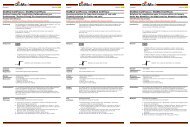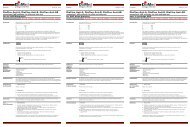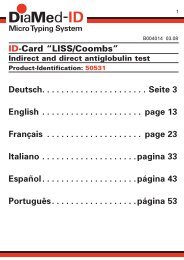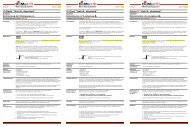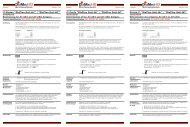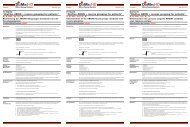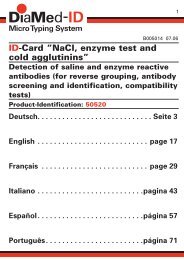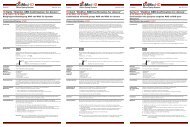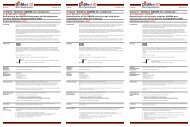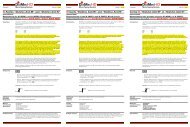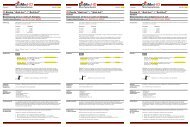Create successful ePaper yourself
Turn your PDF publications into a flip-book with our unique Google optimized e-Paper software.
1 - CLINICAL VALUE<br />
The etiologic agent of Acquired Immunodeficiency Syndrome (AIDS) is a retrovirus which has been named Human<br />
Immunodeficiency Virus (<strong>HIV</strong>). <strong>HIV</strong> has been isolated from patients with AIDS and from healthy persons at high risk<br />
for AIDS 1,2 . Transmission is known to occur by intimate sexual contact, through the use of contaminated needles, by<br />
transfusions of contaminated blood products, and perinatally from infected mother to fetus or child. 1-8<br />
Evidence of previous exposure to <strong>HIV</strong> is usually demonstrated by the presence of virus-specific antibody in an<br />
individual's serum or plasma after exposure to the virus. Prior to the appearance of detectable antibodies, there is<br />
an early period of time when free viral antigens circulate in the blood. One of these viral antigens is the major viral<br />
core protein, p24. <strong>HIV</strong> antigen assays can be used to detect the presence of viral antigens, and thus <strong>HIV</strong> infection,<br />
prior to seroconversion. The antigenemic period preceding the appearance of <strong>HIV</strong> antibodies is variable and can<br />
last for days or weeks in infected individuals. As an individual seroconverts, virus specific antibodies complex with<br />
the circulating antigens such that the levels of free antigens in the blood drop or disappear entirely. 9-11 Antigenemia<br />
may develop again later as the disease progresses. 12<br />
The <strong>GENETIC</strong> SYSTEMS <strong>HIV</strong>-1 Antigen <strong>EIA</strong> is intended to be used as a screen for donated blood and plasma and<br />
as an aid in the diagnosis and prognosis of <strong>HIV</strong>-1 infection.<br />
2 - PRINCIPLE OF THE <strong>GENETIC</strong> SYSTEM <strong>HIV</strong>-1 ANTIGEN <strong>EIA</strong><br />
The Genetic Systems <strong>HIV</strong>-1 Antigen <strong>EIA</strong> is an enzyme immunoassay for the detection of <strong>HIV</strong>-1 core antigen (p24)<br />
in human serum and plasma specimens. The «<strong>GENETIC</strong> SYSTEMS <strong>HIV</strong>-1 Antigen Confirmatory» Test (code 71121)<br />
is a supplemental assay used with the <strong>HIV</strong>-1 Antigen <strong>EIA</strong> to confirm the presence of <strong>HIV</strong> p24 antigen in repeatedly<br />
reactive samples.<br />
The <strong>GENETIC</strong> SYSTEMS <strong>HIV</strong>-1 Antigen <strong>EIA</strong> is based upon the use of a solid phase prepared with mouse<br />
monoclonal antibody to <strong>HIV</strong>-1 Antigen, of a first conjugate prepared with biotinylated sheep anti-p24 antibody and<br />
a second conjugate prepared with avidin coupled to peroxidase of Raifort.<br />
The performance of the test includes the following reaction steps :<br />
1. Specimen Diluent is added to each well. The samples to be tested and the control sera are added to their<br />
respective wells. If <strong>HIV</strong>-1 <strong>Ag</strong> is present in the specimen, it will bind to the antibodies coated on the well. Any <strong>HIV</strong>-1<br />
<strong>Ag</strong> bound to the well will remain during the subsequent washing.<br />
The color of the Specimen Diluent changes from green to blue to confirm that a sample (or control) has been added<br />
to the well.<br />
2. Conjugate 1 is then added to each well and the wells are incubated. This allows the biotinylated sheep anti-p24<br />
antibody in Conjugate 1 to bind to any <strong>HIV</strong>-1 <strong>Ag</strong> that is bound to the well. The antigen-antibody complexes remain<br />
bound during the subsequent wash step.<br />
3. Conjugate 2 is then added to the wells and allowed to incubate. The avidin in Conjugate 2 binds specifically to<br />
the antibody-<strong>HIV</strong>-1 <strong>Ag</strong> complexes that are bound to the well. Any unbound conjugate is removed by washing.<br />
4. Working TMB Solution is added to the plate and allowed to incubate. A blue or blue-green color develops in<br />
proportion to the amount of <strong>HIV</strong>-1 <strong>Ag</strong> present in the sample. Color development is stopped by the addition of acid,<br />
which changes the blue-green color to yellow. The optical absorbance of specimens and controls is determined<br />
spectrophotometrically at a wavelength of 450/620-700 nm.<br />
5




